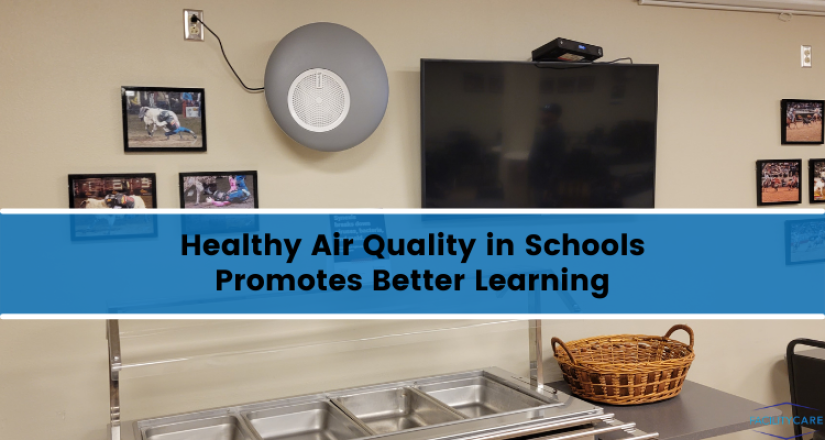
As children spend many hours a day in classrooms during the school year, it’s important for districts to understand how healthy air quality in schools promotes better learning. Each year there are a variety of common illnesses that may affect attendance numbers. However, there are some steps a school can take to provide a higher level of air quality and reduce or eliminate the presence of microbes that are one of the leading causes of viruses, and absences, by extension.
How Healthy Air Quality in Schools Promotes Better Learning
When it comes to understanding why healthy air quality in schools promotes better learning, it is essential to understand the barriers that poor air quality can have regarding campus education. According to the United States Environmental Protection Agency, some negative impacts of poor air quality in a school can include:
- Student and staff discomfort in the learning environment
- Increased student absences
- Decreased productivity of staff and teachers due to sickness or absenteeism
- The accelerated deterioration and reduced efficiency of school equipment which could lead to costly repairs that could require the school to temporarily close
If the air is not properly circulating the flow of oxygen, carbon dioxide can gain dominance in the classroom, which may severely impact how the brain functions. For example:
- Poor air quality = poor learning environment. Research shows that if the air in a classroom is not circulating or filtering properly, it can cause headaches, nausea and may in some cases reduce the ability for the brain to think as clearly.
- Poor learning environment = lower grade scores. If air quality is not at a high level, students often find it harder to concentrate. This can have an impact on their daily learning as well as overall test scores. If a school has low test scores, this can go beyond affecting only the students and may even extend to impact how a school is ranked.
- Absenteeism and behavioral issues. If the classroom environment and air quality is not healthy, students may get fatigued and frustrated with their own ability to properly pay attention and learn, which can lead to behavioral issues.
Finding a Solution for Better Air Quality in Schools
There are basic steps school districts can take to reduce the growth of mold, allergens and other microbial elements that create a toxic environment, such as:
- Dust and clean the rooms every day
- Keep rooms clutter free and take out the trash daily
- Practice good animal care including maintaining their cages and keeping them away from vents
- Drain sinks weekly, even if they have not been used in a while
- Clean ceiling tiles, walls, and classroom lavatories and ensure they are free of leaks
These are practices every school should adopt to protect students, teachers and staff, but these practices alone will likely not be enough to keep bacteria and viruses at bay. Additional resources are needed to make that difference.
One of the groundbreaking technology methods used today in providing better air quality in schools is that of the Synexis Biodefense System, which utilizes dry hydrogen peroxide (DHP) to reduce the presence of bacteria, viruses, mold, odors, and insects in the air without disturbing people’s daily activities.
Essentially the system breaks apart ambient oxygen and humidity molecules already present in indoor environments and reassembles them into DHP. Microbes naturally are attracted to the DHP molecules in an effort to survive, but after attachment the DHP breaks down the outer cell membrane of a microbe and ultimately destroys it.
The dry gas’ molecule of hydrogen peroxide is naturally found in human lungs, making it trusted and safe to use when it is installed and operated correctly. This also allows it to be used during operational hours within the school without risking the safety of those inside the building.
Part of the reason for Synexis’ success is that the gas is able to flow to virtually every corner of an indoor space to reduce harmful bacteria and viruses in the air, on surfaces, and even in harder to reach places.
When it comes to schools, testing protocol used by the Synexis system can look like this:
- Create a baseline. Prior to activation, levels of viruses, bacteria and fungi will be measured to create a baseline.
- 30-Day testing. After activating the Synexis system, conduct a 30-day test to measure the reduction in contaminants on surfaces and in colony-forming units via air sampling.
- Monitor impact of in-person schooling. Additional testing and measurements should be conducted throughout the school year while school is in session.
Benefits of Using the Synexis Biodefense System
While schools may have other options to enhance their air quality such as UV light, bipolar ionization, or hydrogen peroxide vapor and mist generators, most, if not all of these options do not offer the same benefits as Synexis’ DHP difference, which include:
- Effective against surface and airborne contaminants like bacteria and viruses
- Able to effectively get into even hard to reach areas
- Reduction in microbes on a continuous basis
- No generation of ozone
- Reduction in risk of cross contamination or recontamination
- Able to be safely used in occupied spaces
- Features no solvents, chemicals, or odors
- Requires minimal to no manual operation cost
- Offers low operating energy and maintenance cost
- Involves no bright lights
- Is flexible and user friendly in operation
As we’ve learned to think differently about germs, allergens, and unhealthy air around us, having a long-term plan for controlling the air we breathe in schools is a smart way to improve the learning environment and make the classroom a safe place for kids to spend so much of their day. Now that you know healthy air quality in schools promotes better learning, consider incorporating the Synexis BioDefense System in your school.

Leave a Reply
You must be logged in to post a comment.